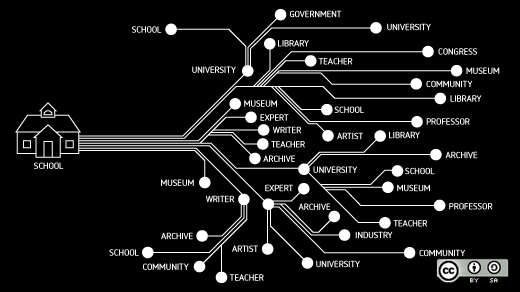What do you get when you combine two hard working women in computing and a 3D printer? Answer after the break...
To get you in the right mindset for thinking about 3D printing, I want to first give you the following assignment:
Don't think about linked list diagrams!
You did, didn't you. I know you did.
If you're a blind programmer, you may, or may not, share the same visual representation for a linked list as sighted programmers. At the moment, I'm not going to make a claim one way or another that having the same mental representation as a sighted programmer matters. That said, if you're in class, and the teacher is yakking away while pointing at the board and drawing diagram after diagram (which just might be playing a critical role in the learning process)... well, it would really be nice to have a clear idea of what some of those diagrams look like, just for the sake of learning.
For example, you might imagine a teacher talking about linked lists, adding and removing cons cells as they go:

Or, perhaps they are talking about hash tables, and talking about what happens when you have key collisions.

Either way, these diagrams need to be translated into something tactile for a blind student. Some people use pipe cleaners, other popsicle sticks... but these are good "on-the-fly" tools, not something that can be chucked in a backpack and referred to throughout the semester. Our thought is that these diagrams could be turned into 2.5D (two-and-a-half dimensional) raised-edge prints so that a blind student could "feel" the edges using open hardware and software.
There are existing technologies to support blind students; in general, those technologies are expensive and proprietary. For example, swell printers cost upwards of $1200, and the paper costs roughly $1/sheet. But a couple of students at Allegheny College and The College of New Jersey think they can leverage open hardware (like the Cupcake CNC) and open software to better support blind students of computing (and other disciplines). They call this project Operation: Stick Figure Army.
This Monday, Stephanie and Sara (both Allegheny '11) saw their printer successfully complete a print! As a project mentor, this was really exciting to see: both of them have learned a great deal along the way, digging into documentation and figuring things out as they go. As they are students at a small, liberal arts college, we don't have an engineering program, so this project represents a whole lot of learning. While building took far longer than we anticipated (it turns out that these things are a bit tricky to build, and we discovered a number of subtle gaps in the documentation), the process was incredibly rewarding. Our colleagues at TCNJ are working hard on their printer, and soon we'll have "feature parity" between the two sites. Then it gets exciting.
Sara, Stephanie, and Cory (TCNJ) are now starting to dig into discussions of project infrastructure and software design. We're on track to dive into the summer full-time, building and testing tools to automagically transform 2D diagrams into 3D prints that blind students can use to see what their teachers are talking about. We're really glad to be working with Cory on this project, because he has first-hand experience with being a blind undergraduate student in a Computer Science program. Along with hacking code, he'll be keeping us honest on accessibility and whether or not the output of our project is usable.
Subscribe to our blog if you want to keep your finger on the pulse; we'll be working in the open, and would ultimately like to see some community build around the tools that we're developing. And as long as I'm singing praises, I should mention that this project wouldn't be possible without the support of the Collaborative Research Experiences Program for Undergraduates (CREU).
Postscript: Why Operation: Stick Figure Army? Because, once you have a 3D printer, you know you really, really want to print an army of little stick figures. Admit it. Yeah, that's what we thought.







Comments are closed.